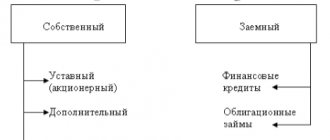Reserve capital on the balance sheet is...
The amount of reserve capital is displayed in line 1360 of the balance sheet, which indicates that reserve capital is a component of the organization’s total capital, reflected in the final line 1300.
The fact that reserve capital is included in the company’s equity capital is also indicated in clause 66 of the Regulations on accounting and accounting, approved by order of the Ministry of Finance dated July 29, 1998 No. 34n (hereinafter referred to as PVBU).
ConsultantPlus experts explained in detail how to reflect reserve capital on the balance sheet and what nuances need to be taken into account when filling out this line. To do everything right, get trial access to the system and go to the Tax Guide. It's free.
You can learn about what a company’s equity capital is from our article “Equity on the balance sheet is...”.
Features of accounting with authorized reserve capital: postings
Score 82.
Article 35 of the Law on Joint-Stock Companies specifies the directions in the form of a list where funds contained in the reserve capital are allowed to be directed. For example, it is prohibited to use it to pay dividends.
At the same time, the legislation mentions that the reserve fund itself is often compiled by several funds, for the formation of which money is deducted from what is called net profit.
Read about the procedure for forming reserves for debts on this page.
200 thousand – total profit for the reporting period. 500 thousand rubles are in a special fund. Finally, 350 thousand rubles are equal to the company’s obligations associated with the obligation to pay dividends to those who have preferred shares.
1. Debit 84. Credit 75.
200 thousand rubles - to indicate net profit, which is used to receive dividends by holders of preference shares.
2. Debit 82. Credit 75.
150 thousand rubles - the amount from which the special fund is formed is also used to pay those who purchased this type of shares.
3. Using the funds in a special fund, it is possible to pay all dividends associated with those who have a certain number of shares of the preferred group. In the same example, we write off the entire amount of 350 thousand, it is written off from the debit of account 82. For other purposes, payments on ordinary shares, we direct the net profit received for a certain period.
Formation of authorized capital in enterprises of various types.
Reserve capital - an asset or a liability?
The company's capital and reserves are considered its liabilities, so it is logical that reserve capital, as a component of equity capital, is, of course, a liability.
In addition, in accounting, information about the state and movement of reserve capital is summarized in account 82, which is also passive.
Reserve capital is intended to accumulate part of net retained earnings, which will subsequently be spent primarily on covering losses.
You will receive more information about liabilities and assets when studying the article “Balance Sheet (Assets and Liabilities, Sections, Types).”
Reserve capital for JSC and LLC - what are the differences?
Unlike LLCs, joint stock companies are required to accumulate reserve capital. For an LLC, the creation of a reserve fund is the right of the company in accordance with paragraph 1 of Art. 30 of the law of 02/08/1998 No. 228-FZ, and not an obligation. At the same time, the size and targeted nature of such a fund for an LLC are not regulated by law, but are prescribed in the charter.
The amount of reserve capital in joint-stock companies cannot be less than 5% of the authorized capital, while the founders can establish a larger size of this fund (clause 1, article 35 of the law of December 26, 1995 No. 208-FZ). The same legislative act specifies the intended use of the fund and the procedure for its formation.
What is the authorized reserve capital of an organization?
The new rules for accounting for reserves provide for the presence of five accounts.
For statutory:
- 82 Dedicated to capital with reserves.
Expenses to come:
- 96 Designation of reserves for expenses for the near future.
For a reserve group of valuation type:
- 63. Dedicated to reserves that arise due to doubtful debts.
- 59. In case securities investments depreciate.
- 14. In case the value of any material assets decreases.
The same capital is needed when it is necessary to repurchase shares owned by management, pay off bonds, and cover incurred losses. In other words, this is the amount to cover losses in situations where other sources have exhausted themselves. The organization's reserve capital is formed in accordance with the law.
Sources of reserve capital.
Reserve capital is used in the following areas:
- To buy back shares or pay off purchased bonds.
- To transfer money to creditor accounts with investors when the underlying profit is insufficient.
- To cover losses that were not provided for.
- Capital group payments.
- Payments related to interest.
- To pay taxes. This is relevant if there is no money, but the deadline is already approaching.
- To write off losses.
- When writing off debts recognized as bad.
There are several more rules associated with this concept. Only the owners of the company have the right to set the accumulation period and the minimum amount for reserve capital.
It is best to start forming reserve capital during the period when the company has retained earnings. The presence of reserve capital will guarantee that the enterprise will operate uninterruptedly in any situation. And that the interests of third parties will always be respected.
How is reserve capital formed?
- In accordance with current legislation, the main source of reserve capital formation is deductions from net profit.
In joint stock companies, reserve capital is formed through deductions from net profit, and the amount of annual replenishment of reserve capital should not be less than 5% of net undistributed profit for the reporting period (paragraph 2, clause 1, article 35 of Law No. 208-FZ). Deductions from net profit in favor of the reserve fund are made until the limit established in the charter is reached.
Example:
The charter of Kolos-info JSC provides for the creation of a reserve fund in the amount of 6% of the authorized capital. The authorized capital at the time of the meeting of the board of directors (02.20.20XX) amounted to 90,000,000 rubles, reserve capital was formed at the level of 5,200,000 rubles. The net profit of Kolos-info JSC for the year 2020 amounted to 6,000,000 rubles.
In accordance with the charter, Kolos-info JSC must create reserve capital in the amount of 5,400,000 rubles (90,000,000 × 6%). To complete the formation of reserve capital, it remains to contribute another 200,000 rubles (5,400,000 – 5,200,000). At the meeting held on February 20, 20XX, it was decided to allocate 200,000 rubles from the net profit of 20XX to replenish the reserve fund.
EXPLANATIONS from ConsultantPlus: Is it possible to indicate in the charter of an LLC that profits are not distributed among the participants, but are sent to the reserve fund or for the statutory purposes of the company? How to reflect this? For answers to these and other questions, see the K+ legal reference system. If you do not have access to the K+ system, get a trial online access for free.
If the company happened to turn to a source of reserve capital to cover losses incurred at the end of the reporting period, then in the next period it will have to again make deductions from net profit until the statutory value is reached.
- In addition to the above method of replenishing reserve capital from a part of retained earnings, there is also the possibility in special cases of forming reserve capital from the property contributions of the founders.
Contributions made by shareholders that are transferred to the company in the form of property, according to clause 2 of PBU 9/99, are not recognized as income of the company. And in sub. 3.4 clause 1 art. 251 of the Tax Code states that income recognized for tax purposes does not include contributions of shareholders with property made in order to increase net assets and funds. This means that they can also be used to form reserve capital.
Based on the above, we can conclude that shareholders, in order to increase net assets, can make contributions with property (moral and property rights) also through the formation of reserve capital.
You will get more information about net assets by studying our articles:
- “How is the accounting value of net assets calculated?”;
- “What are the consequences of negative net assets?”
For example, many non-profit organizations create reserve funds at the expense of share contributions from participants (subclause 16, clause 3, article 1, subclause 1, clause 4, article 6 of the law of July 18, 2009 No. 190-FZ, clause 7, art. 34 of the Law of December 8, 1995 No. 193-FZ). And the chart of accounts for agricultural enterprises, approved by order of the Ministry of Agriculture dated June 13, 2001 No. 654, directly provides for the possibility of forming a reserve fund from contributions from participants.
Example 1:
In order to increase the size of net assets, the shareholders of the agricultural company decided to make a contribution to the reserve capital (hereinafter - RK) in the form of materials in the amount of 100,000 rubles.
In this regard, 2 entries will be made in accounting:
- Dt 10 Kt 75 in the amount of 100,000 rubles - upon receipt of materials from shareholders for the purposes stated above;
- Dt 75 Kt 82 in the amount of 100,000 rubles - formation of the Republic of Kazakhstan.
Example 2:
At the board of shareholders, they decided to increase net assets by making a contribution of 2,000,000 rubles to the RK JSC. Shareholders made contributions in the total amount of 2,000,000 rubles.
In this regard, 2 entries will be made in accounting:
- Dt 51 Kt 75.3 in the amount of 2,000,000 rubles - receipt of funds from shareholders to replenish the Republic of Kazakhstan;
- Dt 75.3 Kt 82 in the amount of 2,000,000 rubles - formation of the Republic of Kazakhstan from contributions made by shareholders.
Read about the nuances of accounting for reserve capital in ConsultantPlus. Study the material by getting trial access to the K+ system for free.
Extra capital
This parameter refers to the part of the enterprise’s monetary assets,
whose actual value has increased as a result of revaluation or other non-financial injections.
https://www.youtube.com/watch?v=ytdevru
Additional capital is formed by summing up four main indicators:
Share premium. It represents a markup on the company's shares for third-party buyers.
- Income from differences in exchange rates. Formed when calculating the share of capital in foreign currency or as a result of transfers. In fact, this value may be negative.
- Markup on the company's own funds. These include the organization's property and means of production.
- Restored VAT (has been a component of additional capital since 2006 by order of the Ministry of Finance No. 07-0506).
Additional capital, postings.
Additional capital contains information about changes in the organization's assets that were not caused by any financial manipulation.
To reflect it in accounting
Additional capital with a negative balance must be reflected without fail
This is also necessary when
- additional injections into the capital of the organization,
- division of assets between founders,
- allocation of his share to one of the company's shareholders.
Example of posting additional capital.
Debit 01, Credit 83 – 100,000 rubles.
Debit 83, Credit 02 – (600,000/500,000)*50,000-50,000 = 10,000 rubles.
100,000 – 10,000 = 90,000 rubles.
This additional capital was formed due to an increase in the average market value of the equipment used.
The rules and necessary procedures for preparing financial statements during the reorganization of an enterprise are determined by Order of the Ministry of Finance No. 44n.
When merging or transforming organizations, no difficulties arise.
A common practice is to close all credit and debit accounts, except No. 84, which is where additional and reserve capital are actually posted.
The methods of forming additional and reserve capital in this case do not matter.
When dividing an enterprise, they are also subject to distribution.
The decision regarding the reserve is based on the goals of creating the funds that form it
https://www.youtube.com/watch?v=ytcreatorsru
For example, if the reserve capital was insurance for shareholders, then its division occurs in accordance with the share of shares.
In the case of an LLC, it is also possible to apply share distribution in relation to the entire authorized capital.
If you find an error, please highlight a piece of text and press Ctrl Enter.
How does the reserve capital increase/decrease?
In a situation where the board of directors has decided to increase the authorized capital, which is within its competence in accordance with Art. 65 of Law No. 208-FZ, and as a result of this it turned out that the size of the reserve fund has become less than the mandatory 5% of the capital, there is a need to increase the reserve capital.
The decision to increase the authorized capital by increasing the par value of shares is made by the general meeting of shareholders (Clause 2 of Article 28 of Law No. 208-FZ).
Example:
At the meeting of shareholders, it was decided to increase the authorized capital from 200,000,000 rubles to 300,000,000 rubles. At the same time, at the time of making this decision, the JSC already had reserve capital in the amount of 10,000,000 rubles. Accordingly, after increasing the size of the charter capital to 300,000,000 rubles, the JSC will have to increase its reserve capital by 5,000,000 rubles (300,000,000 rubles × 5% – 10,000,000 rubles).
If a decision was made to reduce the size of the capital, then there is a basis for reducing the capital. This change can be legally carried out only after state registration of changes in the charter relating to the reduction in the size of the charter capital. The decrease in the RK in accounting is documented by posting Dt 82 Kt 84.
Extra capital
This is another liability item on the balance sheet. It is formed as a result of the revaluation of fixed assets or the issue of shares. Accounting for additional capital is carried out according to the account. 83. CT scan shows:
- increase in asset value;
- a positive difference between the price and par value of shares (when an enterprise is formed or the volume of own funds increases);
- increase in targeted funding;
- exchange rate differences on contributions to the capital of the company, which were made in foreign currency.
A decrease in capital occurs if:
- The value of intangible assets based on the results of revaluation is lower than the balance sheet. The records show DT 87-1 in correspondence with the property account. In parallel, a decrease in depreciation must be reflected.
- Funds are allocated to increase the UK - CT 75 (80).
- The amount of capital is distributed among the founders - KT 75.
- Losses for the reporting year were written off - KT 84.
Analytical accounting of additional capital occurs as follows:
| DT | CT | |
| Increased OS wear | 02 | 02 |
| Reduced cost of intangible assets | 01 | 01,03 |
| Income received from the issue | 75 | |
| Increased capital | 80 |
Reserve and additional capital can be used for:
- increase in UK (K80);
- repayment of losses for the reporting year (K84);
- distribution of dividends among shareholders.
Results
For joint stock companies, reserve capital for a specific intended use is a mandatory component of equity capital. Its size is strictly defined at the legislative level and cannot be less than 5% of the authorized capital. The composition of the Criminal Code of the joint-stock company is established by the norms of Art. 99 of the Civil Code of the Russian Federation and Art. 25 of Law No. 208-FZ.
When changing the company's charter capital, it is also necessary to review the amount of reserve capital.
If an increase in the capital has been made, and the size of the formed capital has become less than the limit, then it should begin to be filled from net profit or, in cases established by law, from property contributions from shareholders aimed at increasing net assets (or share contributions). You can find more complete information on the topic in ConsultantPlus. Free trial access to the system for 2 days.




